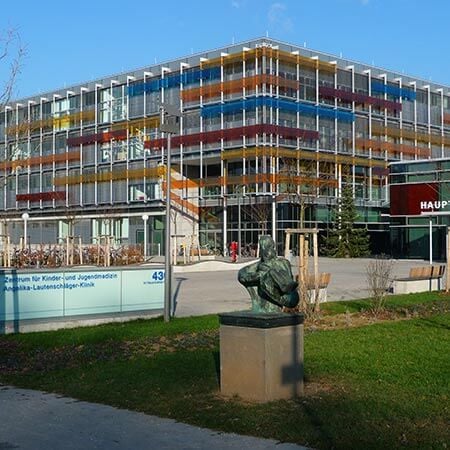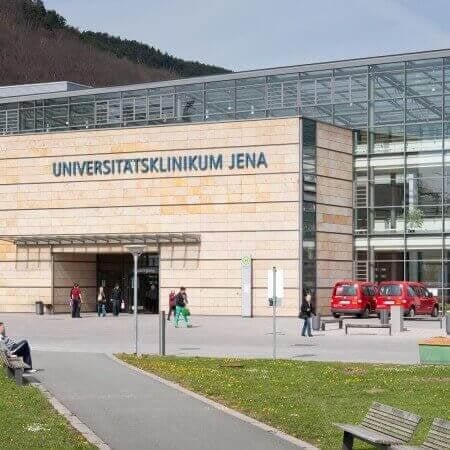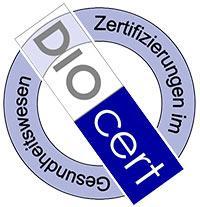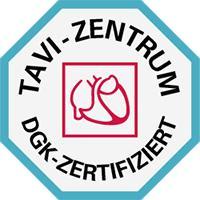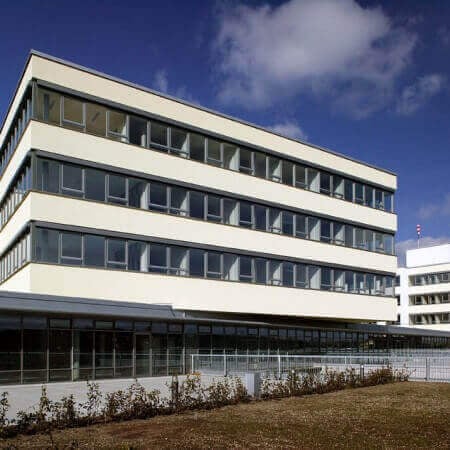The condition becomes a source of recurring inflammatory processes, disrupting respiratory function and reducing quality of life. You can undergo your diagnostics and treatment in Germany. In 90% of cases, German doctors manage to achieve good results without any surgery.
Content
- What is bronchiectasis?
- Conservative treatment
- Surgical treatment
Bronchiectasis is usually treated with conservative methods such as antibiotics, mucolytics, mannitol inhalation, inhalation corticosteroids, physiotherapy, and respiratory muscle development exercises. Occasionally, doctors may resort to surgical techniques and video-assisted thoracoscopic surgery.
You can seek medical attention from the Academic Hospital Augustinerinnen Cologne, the University Hospital Frankfurt am Main, or the University Hospital Heidelberg.
The Booking Health company will take care of all the arrangements for your trip to Germany. Our employees will help you to choose a Pulmonology Clinic, make an appointment without a long wait, help you to apply for a visa and come to the hospital, take care of the translation of medical documents, and you will also be accompanied by an interpreter. Until you return home, a personal medical coordinator will always be in touch with you for any questions that may arise.
What is bronchiectasis?
Bronchiectasis is an expansion of medium and small bronchi, accompanied by inflammation, chronic bacterial infection, and destruction of their walls. This is usually a complication of an infectious or other inflammatory process (autoimmune, radiation, etc.). In addition, multiple bronchiectasis results from cystic fibrosis.
In developed countries, bronchiectasis is becoming less common, and this is due to a decrease in the prevalence of tuberculosis and an increase in the effectiveness of pneumonia treatment.
Bronchiectasis is characterized by a persistent cough and recurrent infections. They are dangerous not only in themselves, but also aggravate the course of other bronchopulmonary diseases such as bronchial asthma and COPD (chronic obstructive pulmonary disease).
Conservative treatment
When dealing with bronchiectasis, doctors use conservative treatment methods such as pharmacological and non-pharmacological approaches. These are used to suppress infection, reduce the frequency of exacerbations, improve breathing, increase physical endurance, maintain work capacity, and improve quality of life.
Conservative treatment of bronchiectasis in Germany can be carried out using the following methods:
- Airway clearance techniques may include chest drainage, postural drainage, bronchopulmonary hygiene vibration, and mucociliary clearance. According to the St. George's Respiratory Questionnaire, these procedures improve the quality of life, but it is important to individually approach the choice of technique.
- Long-term antibiotic use is a treatment approach when drugs are prescribed for a course of 4 weeks or more. This reduces the bacterial density of sputum, reduces the frequency of exacerbations, and the severity of symptoms. Antibiotics can be used both systemically and locally, or as inhalations.
- Inhalation corticosteroids can be prescribed for poorly controlled symptoms, as they increase the risk of infections. Corticosteroids dilate the bronchi, reduce inflammation, and make breathing easier.
- Mannitol inhalation is another conservative treatment option. The goal of hyperosmolar inhalation therapy is to improve tracheobronchial mucociliary clearance by bringing fluid to the airway surface.
- Mucolytics can be useful during an exacerbation period. These drugs are used in short courses. They break down mucus, making it less viscous and making it easier to cough up.
- Pulmonary rehabilitation involves performing exercises to train the respiratory muscles, improves the quality of life, and increases exercise tolerance. Pulmonary rehabilitation can often be combined with physiotherapy in the chest area.
Surgical treatment
Surgical treatment of bronchiectasis is rarely required since, in 90% of cases, the disease can be controlled with conservative therapy. The operation is done if the symptoms are severe, exacerbations of infections are too frequent, pulmonary bleeding or other complications develop.
A segmental resection or a lobectomy involves the removal of part of the lung. In its classical version, this surgical procedure is traumatic and is performed through a large incision in the chest. In Germany, however, it is often done with minimally invasive techniques. Video-assisted thoracoscopic surgery is performed through short incisions and with thin long instruments under the guidance of a tiny video camera. Some clinics in Germany offer their patients robot-assisted interventions, which are even safer, accompanied by less blood loss and a relatively short rehabilitation period.
You are welcome to use the Booking Health service if you want to undergo your treatment at one of the Pulmonology Centers in Germany. On our website, you can compare the cost of treatment and make your appointment at the hospital at the best price. Our employees will help you to choose the most suitable hospital and take care of the organization of your trip.
Authors:
The article was edited by medical experts, board-certified doctors Dr. Sergey Pashchenko and Dr. Vadim Zhiliuk. For the treatment of the conditions referred to in the article, you must consult a doctor; the information in the article is not intended for self-medication!
Sources:
National Library of Medicine
MedicineNet
Johns Hopkins Medicine
